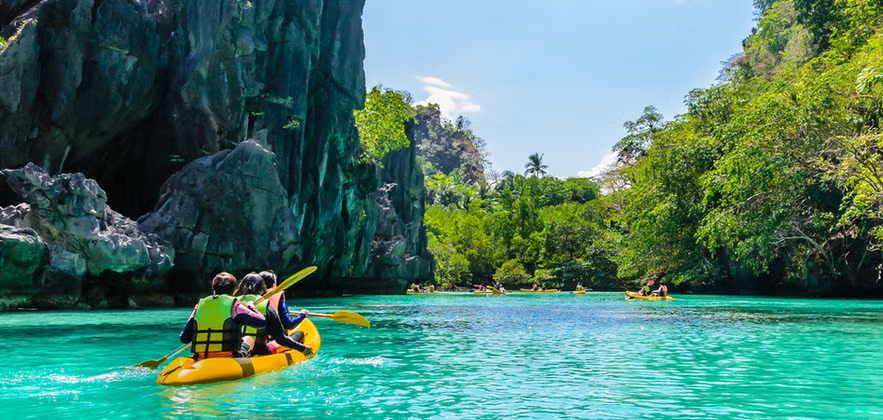Palawan, Philippines travel tips
Category
Categories
Popular Articles

## Overview of the Destination
Palawan, affectionately labeled as the “last ecological frontier of the Philippines” is one of the most admired tourist destinations in the country. It’s carved a niche for itself in the world of tourism, mainly for its exotic wildlife, pristine beaches, stunning underwater landscapes, and a wealth of UNESCO World Heritage sites. Palawan is an archipelago of over 1,700 islands wrapping around in a dreamy paradise package for nature lovers, honeymooners, dive enthusiasts, and adventure seekers. The most popular attractions include El Nido, Puerto Princesa Subterranean River National Park, and the Tubbataha Reefs Natural Park.
## Best Time to Visit
The best time to visit Palawan is during the dry season, typically between November and May when you can expect minimal rainfall and blue skies. The peak tourist season is between December and March. But don’t discount the off-season benefits, where lesser tourists make for a more authentic experience, plus the costs for accommodation and flights may be cheaper. Festival-wise, the Baragatan Festival in June is particularly vibrant, celebrating the founding of Palawan with parades, contests, and trade fairs.
## Climate & What to Pack
Palawan enjoys two main seasons: the dry season (November-May) and rainy season (June-October). Regardless of when you visit, pack lightweight, breathable clothing, swimwear, a raincoat, sturdy shoes for trekking, and don’t forget your sun protection essentials like a hat, sunglasses, and sunscreen. Also, ensure to pack your camera for the breathtakingly beautiful landscapes Palawan has to offer.
## Getting There
The primary entry points to Palawan are through its two airports in Puerto Princesa and El Nido. From Manila, it’s roughly an hour’s flight. International travelers will need to check their visa requirements, but nationals from 157 countries can enter the Philippines for 30 days visa-free. From the airport, there are taxis, vans, and tricycles available for transportation to the city center or your hotel.
## Getting Around Locally
Public transportation in Palawan includes jeepneys and tricycles. For a more comfortable ride, air-conditioned vans and taxis are available. Renting motorbikes or e-bikes is also a popular choice for getting around areas like El Nido. Boat rentals are often utilized for island hopping and discovering secluded beaches.
## Safety Tips
Palawan is generally safe, but remember to exercise common sense. Avoid remote areas after dark, keep an eye on your belongings, and beware of occasional tourist scams like overcharging for transport. There’s a conservative culture, so be respectful and dress modestly, especially when visiting churches or local villages.
## Top Things to Do & See
Where to start? Visit the UNESCO-listed Underground River in Puerto Princesa, marvel at the limestone cliffs and colorful marine life while snorkeling in El Nido, dive the Tubbataha Reefs Natural Park, and hike the jungle trails to reach the remote beauty of Kayangan Lake in Coron. Don’t miss trying the local experience of a traditional Filipino ‘Boodle Fight’ meal.
## Where to Stay
Whether you’re a budget backpacker or luxury seeker, Palawan has a wealth of accommodations to choose from. For high-end options, El Nido Resorts and Amanpulo offer luxury amidst nature. Mid-range travelers could consider places like Deep Forest Garden Hotel and Astoria Palawan. Budget options include hostels like Our Melting Pot and Spin Designer Hostel.
## Food & Local Cuisine
Palawan boasts a unique gastronomic scene, featuring locally grown ingredients. Seafood is prominent, with dishes like kinilaw (raw fish salad) and tamilok (woodworms), and of course, the famous Lechon, which is a must-try! Popular places to eat include Badjao Seafront in Puerto Princesa and Cadlao Resort & Restaurant in El Nido.
## Cultural & Practical Tips
The local currency is the Philippine Peso (PHP), and English is widely spoken. Tipping is appreciated, but not compulsory. Power outlets are 220V, and Wi-Fi can be unpredictable at times, so consider getting a local SIM card. Respect the local customs and traditions, learn a few local words, and you’re good to go!
## Sustainable or Responsible Travel Tips
Tourism impacts sustainability. Be mindful of your actions to respect the local environment. Dispose of trash properly, avoid touching or stepping on corals, use reef-safe sunscreen, abide by park rules, and opt for tours accredited by the local tourism board.
## Personal Travel Tip
Lastly, get out of your comfort zone. Try local delicacies, immerse yourself in the beautiful culture, and respect nature. Palawan will inspire and enthral, leaving you with memory-filled, connected, and sustainable experiences. Remember, you’re not just visiting Palawan; you’re making memories.










